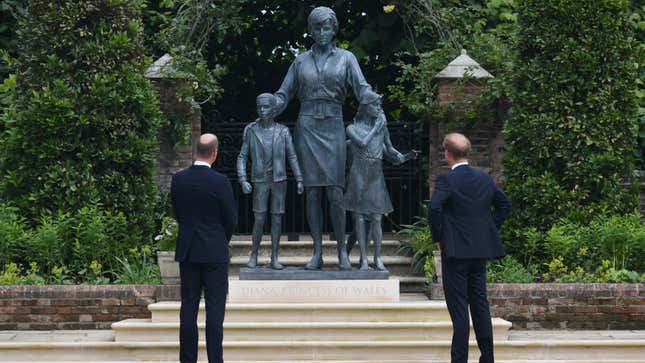At Unveiling of Diana Statue, William and Harry Are Still on Different Paths
Unveiling a statue in their mother's memorial underscores how far apart Will and Harry are
CelebritiesRoyals
Image: (Photo by DOMINIC LIPINSKI/POOL/AFP via Getty Images)
Today, Prince William and Prince Harry reunited at Kensington Palace for the unveiling of a statue memorializing their mother, who would have turned 60 years old today. The statue they ultimately unveiled fuses Diana’s role as philanthropist and mother, depicting her standing with two children, her hands protectively on their shoulders. Initially announced jointly, the occasion has become another closely watched public litmus test of the rocky relationship between the brothers. The world’s media is waiting with one question: Can this “heal the breach?” The event is being framed as a possible moment of familial repair, a healing opportunity. Instead, it underlines the separate paths they have taken—one man inside the palace, and another out.
The statue was initially announced under a very different set of circumstances. Harry was still working closely with his brother and sister-in-law out of a joint office in Kensington Palace; the pair announced the statue in a statement that spoke as one voice: “It has been 20 years since our mother’s death and the time is right to recognize her positive impact in the U.K. and around the world with a permanent statue. Our mother touched so many lives. We hope the statue will help all those who visit Kensington Palace to reflect on her life and her legacy.” Harry and Meghan were dating, but she hadn’t yet moved to the United Kingdom. The Crown hadn’t dredged up the full, ugly history of Charles and Diana’s relationship, either; Charles’s reputation came through the year of the anniversary of her death relatively unscathed. Things have changed dramatically since. The Windsors have been in such turmoil that the much-reduced size of the ceremony due to a global pandemic seems like a comparative blip on the radar.
The announcement of plans for the statue was just one element of the celebrations of her life. William and Harry also collaborated for a documentary that aired in the US and UK, titled Our Mother, Diana, a project whose very name illustrates how closely joined the pair were. It was a delicate dance, memorializing a woman who is still beloved and wildly popular, but who was publicly at odds at the end of her life with the very Crown that William will eventually wear, issues that were left unresolved when she died. The documentary opened and closed with the two brothers sitting together over an old photograph of a pregnant Diana holding a toddler William, all three of them together in one shot, after a fashion.
-

-

-

-

-

-

-

-

-

-

-

-

-

-

-

-

-

-

-

-

-

-

-

-

-

-

-

-

-

-

-

-

-

-

-

-

-

-

-

-








































